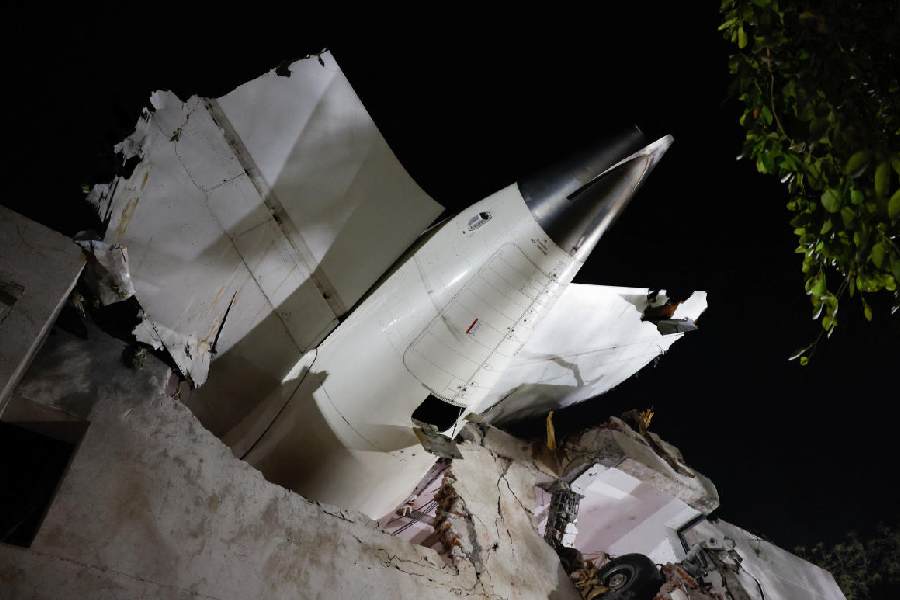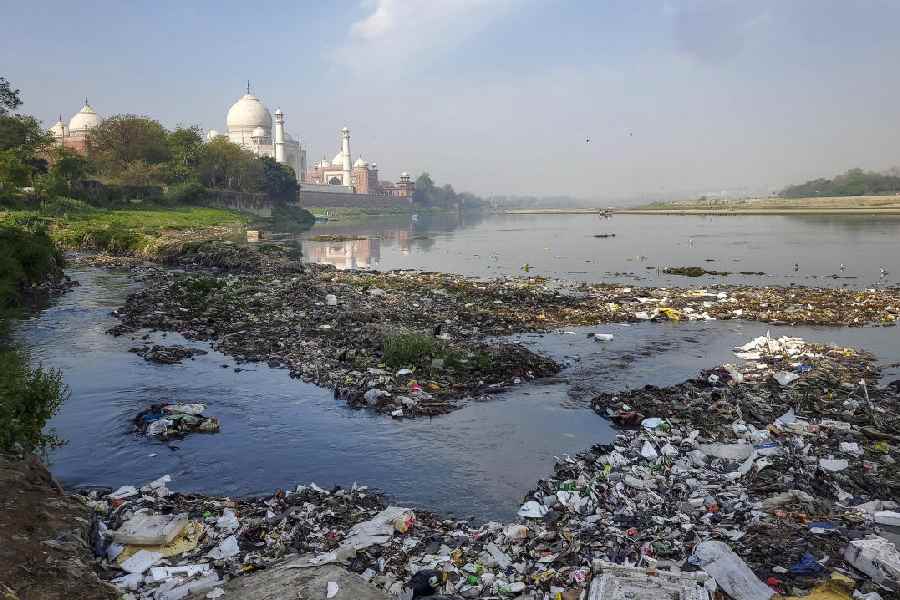 |
| A promenade along the riverfront at Millennium Park and (below) shops and pice hotels hide the river in front of Howrah station on the western bank. Pictures by Sanjoy Ghosh and Anup Bhattacharya |
 |
Travelling across the more than 70-year-old Howrah bridge to reach the west bank of the Hooghly, one can’t but marvel at the sight of the mighty river. Dotted with steamers, buoys and boats that navigate its muddy waters, the expansive stretch of water meanders across in a north-south direction.
Cross the western embankment and the river disappears behind ugly and ageing concrete, blocking the riverfront right from the Howrah bridge down south up to Shalimar station and to the north till Bally bridge, barring the occasional ghat offering a fleeting glimpse of the river.
East or west
While the eastern bank of the Hooghly boasts a 5km promenade, beautified with lights, benches and statues, the western bank has just a 425-metre stretch from Ramkrishnapur Ghat along the length of Grand Foreshore Road to show for at present.
Ambitious plans are in store though. “We plan to create a 13km marine drive from north Howrah to south Howrah along the riverside. It will be a high-speed lane so that vehicles can travel through without any hindrance,” revealed Debaprasad Dutta, the chief engineer of the Howrah Municipal Corporation (HMC).
 |
| Foreshore Road |
But there is hardly any vacant land along the riverfront. “Unlike Calcutta, we do not have the Strand Road on the west bank. The disposition here is very different,” said mayor Rathin Chakraborty. “We have got a map of the riverfront prepared by professors of the Indian Institute of Engineering Science and Technology (IIEST). But the major part of the riverfront is private land, much of it occupied by factories. We are in talks with the Howrah Chamber of Commerce (HCC) to see if these could be vacated for a ring road or marine drive that would house our version of the London Eye, which has been Didi’s dream.”
The president of HCC, while welcoming the beautification drive, hinted it could be a time-taking endeavour. “The interests of labourers, factory workers and factory owners shall have to be taken into account for reclaiming any land. We have had preliminary talks on this.”
Chakraborty knows things may be easier said than done. “Howrah is an unplanned city, 527 years old. We have to approach it from two angles. Just like we have Old Delhi and New Delhi, similarly we will have the old Howrah stretch in the north, where we will try and restore the city and the new Howrah stretch which we will develop.”
 |
| Chandmari Ghat |
Gateway to Howrah
The gateway to Howrah itself is more than a century old. The heritage structure of Howrah station looks over the river from the western bank.
As passengers step out of the station, they are at once confronted by a row of dilapidated structures — Janata Travels, Sri Ganga Hindu Hotel, Bijay Hindu Hotel, Sonkar Communications, a pay-and-use toilet, a Mother Dairy booth, some abandoned stalls — that block the view of the river.
“Howrah, we were told, is by the riverside, but we don’t get to see it anywhere,” rued Reshma, just arrived from Chennai to meet her aunt. “Maybe, my aunt will take me to the riverside during my stay here.”
Tucked away beyond Reshma’s view lay Chandmari Ghat, its entrance sandwiched between the Mother Dairy booth and the Water Surface Transport office.
An old red brick structure with wide staircases on either side leads to the river. A barber sits on the stairs, which bear watermarks from the high tide, cleaning the ear of a man sitting on an empty Exide battery shell. Another is having his mid-afternoon bath in the Hooghly waters while two others snooze on the ghat steps, gamchha over their faces acting as sunshields.
 |
| Rashbari Ghat |
Building blocks
Walking down further, keeping the new Howrah station complex to the right, one comes across a stretch of vacant land that now serves as a parking lot. Covered with shrubs and vegetation, the fallow land seems to have no takers.
The HMC chief engineer, along with his counterpart in the Calcutta Municipal Development Authority (CMDA), has identified the stretch for beautification, complete with a statue of Rabindranath Tagore commissioned to a professor of the Government College of Art and Craft.
“We will clear the jungle and beautify this spot. There will be a garden and a cafetaria,” promised Dutta. “It will be subsidised and serve as a substitute for the pice hotels.”
The pice hotels were forced to shut down, following a court order, to save the Hooghly from pollution. But behind the shutters thrive illegal eateries catering to hundreds every day.
The structures cannot be pulled down as the land belongs to the Calcutta Port Trust (CPT), admitted Dutta. The railway authorities agree. “Let CPT do it,” said Ravi Mahapatra, CPRO, Eastern Railway.
The port trust, on the other hand, says notices have been issues to all authorities concerned that “no constructions can be built within 150ft of the bank”. “We sent letters to everyone and it has been officially notified in the gazette in 2001,” said a spokesman for CPT.
The shacks aren’t the only obstruction in the line of vision. Beyond the fallow land that the HMC and CMDA hope to beautify runs a 12ft colourful wall all the way up to Telkolghat Road. “Oh, we have a railway officers’ club there, the Riviera,” said Mahapatra. The club premises, well within 150ft of the riverbank, remains out of bounds for the public.
 |
| Nimtala Ghat |
View of Hooghly
Approaching Grand Foreshore Road, with the dilapidated Burn Standard factory on the right and Telkolghat Road veering off from its side, one reaches the only bright spot on the western bank. Black-and-white chequered tiles pave the walkway that has a pristine white balustrade, granite benches and trident lamps all the way.
The stretch includes the old Ramkrishnapur Ghat with its wrought iron structure freshly painted white. A drive past Grand Foreshore Road offers a clear view of the Hooghly with the landmark SBI headquarters on the eastern bank. A fleet of blue-and-white radio cabs line the road with drivers lounging at the wheel. “We have parked here so we can enjoy the breeze. It’s cool,” said Ramratan, a radio cab driver.
Lost to the eye
Grand Foreshore Road takes a turn to the right and leads to the newly repaired and lit-up Foreshore Road. However, the riverfront is lost from here on. Factories — some closed — slums, godowns, workshops and car showrooms line the entire stretch of the Hooghly, blocking the view from Foreshore Road. “We have to reclaim land here if we are to build that road along the river,” admitted Dutta of the HMC.
A committee headed by the mayor, the district magistrate, the police commissioner, Howrah ministers, MLAs, councillors, the chief engineer of the Howrah Improvement Trust, CMDA and the Howrah Chamber of Commerce has been formed to chalk out a plan. “The major bottleneck here is the stretch from Ramkrishnapur Ghat to Shibpur Ghat,” said the engineer, adding that a flyover will be built from Shalimar to the erstwhile Besu campus.
Duke Road and Jagat Banerjee Ghat Road that leads towards Vivekananda Setu and the Nabanna area will be cleared up and renovated soon. “These roads will be off limits for people for security purposes as the area is too close to Nabanna,” said Dutta.
 |
| Riviera Rail Club |
At the ghats
Travelling along the newly repaired GT Road and onto Howrah Road towards north Howrah, there is no sign of the river except through the narrow lanes leading to the innumerable ghats dotting the west bank.
Starting from Dashami Ghat, opposite Kashipur Ghat on the east bank, to Pathak Ghat and Nimtala Ghat, the river is lost to an array of structures, domestic dwellings, shops, libraries and club buildings.
Rashbari Ghat of the Purna Chandra Daw family has a sprawling temple courtyard. As the sun goes down on the west bank and the sky turns crimson, the temple complex turns into a meeting ground for senior citizens, children, homemakers and sundry others. “We love coming to Rashbari Ghat. It’s nice to sit by the river and hear the kansor ghanta during the evening arati. It’s so peaceful,” said Purnima Basak, a regular.
The river might be lost in most parts of Howrah, but it is these ghats that act as windows to the quietly flowing Hooghly.
Additional reporting by Amrita Ghosh










